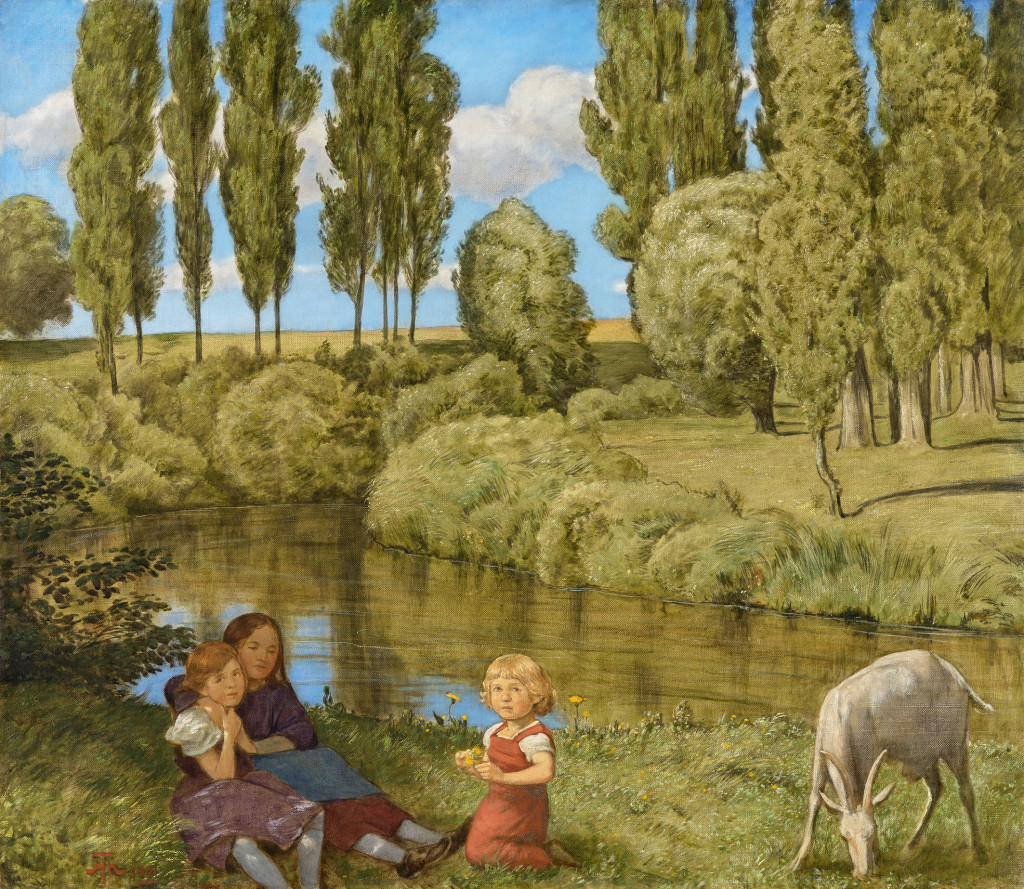Hans Thoma
(Bernau 1839 - 1924 Karlsruhe)
“Am stillen Bach“ (Quiet Waters), 1901
Oil on canvas, 86.5 x 100 cm
Monogrammed and dated lower left HT 1901
Provenance:
Robert Schwarzenbach-Zeuner (1839-1904), Zurich (1902)[1]
Frau R. Schwarzenbach-Zeuner, Zurich (by 1909)[2]
Galerie Theodor Fischer, Lucerne
Kunsthandel Norbert Nusser, Munich
Georg Schäfer private collection, Schweinfurt
German private collection
Exhibited:
Deutsche Kunst-Ausstellung, Düsseldorf, Kunstaustellungs-Gebäude, 1 May-20 October 1902, no. 148
Hans Thoma, Bern, Kunsthalle Bern, 11 May-9 June 1924, no. 141
Hans Thoma: Gemälde und Zeichnungen aus der Sammlung Georg Schäfer Schweinfurt, Schweinfurt and elsewhere, 1989-90, no. 47
Literature:
Kunstwart-Verlag (ed.), Thoma-Mappe, Munich 1902, repr.
Henry Thode, Thoma, des Meisters Gemälde, Stuttgart 1909, repr. p. 431
Hans Thoma almost certainly painted this peaceful riverscape in the summer of 1901. Only a few months later, in November 1901, his wife Cella would die unexpectedly. The family was still living in Frankfurt although Thoma had been appointed director of the Karlsruhe Kunsthalle and professor of the Großherzogliche Kunstschule two years earlier. He had already depicted the same landscape in two other paintings, both executed in 1890.[3] All three paintings concentrate on a stretch of the river Nidda near Frankfurt. The facial features of the dark-haired young woman in the present painting resemble those of Cella Thoma as a girl, and the children have similarities with Cella’s niece Ella. Thoma frequently used their likenesses in his paintings.
This pastoral river scene with its tall poplars, bushes and watermeadows is very characteristic of the Nidda Valley. The two girls are seated in the shade towards the left of the image and a small girl in a red tunic kneels at their feet at the centre. The figures have paused to look quizzically at the viewer, while a grazing goat is seemingly unconcerned.
The style of execution is entirely characteristic of Thoma’s late work. Paint is very thinly applied and the emphasis on contours lends the composition the graphic quality of a hand-coloured drawing. The red of the child’s tunic lends a dynamic element to the pastel tones of the surrounding landscape.
Thoma was self-taught in his youth but went on to train under Johann Wilhelm Schirmer at the Großherzoglichen Kunstschule in Karlsruhe in the years 1859-66. A visit to Paris with his friend Otto Scholderer was highly important to his artistic development. Meetings with Gustave Courbet, Théodore Rousseau and Jean-François Millet, and exposure to the work of Edouard Manet clearly had a formative influence on his painting. Thoma, however, regarded their work as a ringing endorsement of his own, mature artistic convictions. From 1868 to 1870 he spent the summers in Bernau in the Black Forest and the winters teaching in Karlsruhe. In 1877 he married his pupil, Cella Berteneder, and they made Frankfurt their permanent home. Visits to England and Holland, and extended visits to Italy followed. The exhibition of thirty-six of his works at the Kunstverein in Munich in 1890 marked a career breakthrough. Demand for his paintings reached remarkable levels and a stream of public awards followed. He was made an honorary member of the Munich Academy in 1895. He was appointed director of the Kunsthalle and professor of the Großherzogliche Kunstschule, both in Karlsruhe, in 1899. He was to step down in 1919. In 1902 he was awarded the Bavarian Maximilian Order for Science and Art, and in 1903 he received an Honorary Doctorate from Heidelberg University. His artistic career is generally considered to have peaked around the turn of the century.[4]
[1] Robert Schwarzenbach-Zeuner was a Zurich-based silk merchant and art patron. He owned the fifth version of Arnold Böcklin’s Villa by the Sea. Urs Widmer, ‛Schwarzenbach’ in Neue Deutsche Biographie , 24/2010, pp. 15-16: <http://www.deutsche-biographie.de/pnd129517666.html>, (accessed 18.01.2016).
[2] Probably Renée Schwarzenbach-Zeuner (née Wille, 1883-1959) who was married to Robert Schwarzenbach-Zeuner’s second son Alfred (1876-1940). A writer, journalist and photographer, she was the daughter of General Ulrich Wille (1848-1925), Commander-in-Chief of the Swiss Army in the First World War. Thoma’s biographer Henry Thode lists a second Thoma painting in Renée Schwarzenbach-Zeuner’s possession (1909); see Thode, Thoma, des Meisters Gemälde, Stuttgart 1909, p. 413, Frühlingsmärchen.
[3] Hans Thoma, Stiller Bach – Quiet Waters, 1890, oil on canvas, 88 x102 cm. See Thode, op. cit., 1909, repr. p. 324 and p. 515, no. XXXVII.
[4] See Bruno Bushardt, Hans Thoma, 1839-1924 exhib. cat., Schweinfurt, Sammlung Georg Schäfer, 1989-90, pp. 9-11; Thode, op. cit., 1909; Gustav Keyssner, Thoma, Stuttgart and Berlin 1922.

